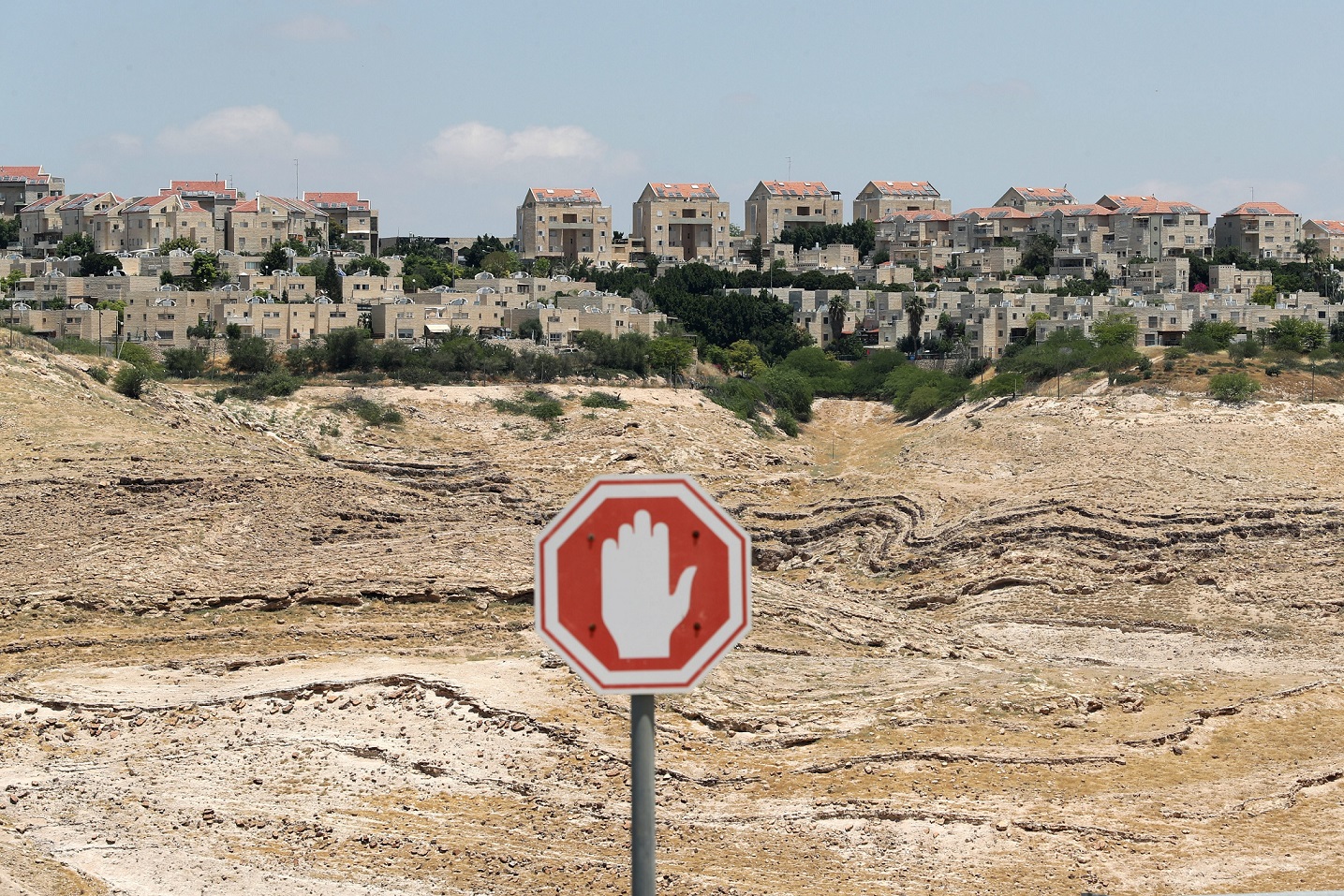Publications
Special Publication, July 8, 2020
Israel’s process of annexing West Bank territory has restored the Palestinian issue to center stage, after Jerusalem succeeded over the past decade in pushing the issue to the margins of the regional and international agendas. The Institute for National Security Studies (INSS) conducted a war game to examine the ramifications of Israel’s application of sovereignty over territories in the West Bank. In the scenario, following the Israeli government’s decision to apply sovereignty in limited scope to settlement blocs in the Jerusalem environs, the President of the Palestinian Authority declared the establishment of an independent Palestinian state within the 1967 borders. While Israel’s move was not recognized internationally except by the United States, most countries did recognize the Palestinian state. Almost immediately, a series of escalating events began in the Israeli-Palestinian sphere and beyond. During the game, the increased loss of control over these events spurred the various relevant actors to accede to a plan by the Quartet regarding suspension of both the annexation and establishment of the Palestinian state, and a return to the negotiating table with President Trump’s plan one of the terms of reference for those negotiations, along with the Arab Peace Initiative. In the game – as in reality – tactical events were what determined the Israeli strategy. It became clear that the decision making process in Israel reflects short-term thinking on exploiting opportunities while President Trump in the White House and does not at all take into account the direct or indirect consequences of dramatic steps that change the rules of the game. In the war game, a way was found to exit this trap, but in reality it is questionable whether this exit will be accessible or practical.
Israel’s process of annexing West Bank territory has restored the Palestinian issue to center stage, after Jerusalem succeeded over the past decade in pushing the issue to the margins of the regional and international agendas. The Institute for National Security Studies (INSS) conducted a war game to examine the consequences of Israel’s application of sovereignty over territories in the West Bank. What follows is a description of the initial scenario and the dynamics of the war game, and the insights that emerged from the exercise.
The Scenario and Subsequent Developments
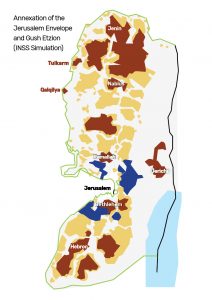
On July 28, 2020, Prime Minister Benjamin Netanyahu announces at a press conference that with the agreement of the Blue and White party, he intends to bring for government approval the application of Israeli sovereignty to settlement blocs surrounding Jerusalem. The area includes Maale Adumim, E1, Givat Ze’ev, Gush Etzion, and Beitar Illit. The following day, Palestinian Authority President Mahmoud Abbas calls a press conference and announces the establishment of a Palestinian state within the 1967 borders, and calls on the international community to recognize the state quickly. Israeli intelligence sources warn of unrest in the Palestinian street against the PA and intensified activity by Tanzim cells, while the Palestinian security forces are almost completely absent from the urban areas in the West Bank and have ceded the area to armed gangs.
Beginning on July 30, there are a series of explosive events
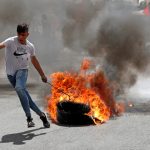
A group of Palestinian youths seize a hilltop between Psagot and Kochav Yaakov and announce over social media the establishment of a new community in the sovereign state of Palestine. The PA spokesman tweets that the PA is sending national security forces to ensure that the IDF does not try to evacuate the outpost that was established on private Palestinian land.
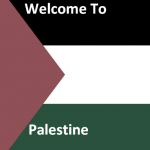 The takeover of the hilltop is the first in a series of events that are part of a campaign by the PA to "liberate" Area C, in which other Palestinian outposts are established with improvised structures. Signs and flags welcoming those “entering Palestinian territory” are erected on various routes throughout the West Bank, and national security vehicles patrol the routes serving Palestinians.
The takeover of the hilltop is the first in a series of events that are part of a campaign by the PA to "liberate" Area C, in which other Palestinian outposts are established with improvised structures. Signs and flags welcoming those “entering Palestinian territory” are erected on various routes throughout the West Bank, and national security vehicles patrol the routes serving Palestinians.
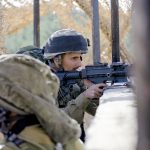
A vehicle with foreign reporters trying to reach the Palestinian outpost in order to cover the story is stopped at the Hizmeh checkpoint and attempts to break through. IDF soldiers, who suspect that this is a ramming attack, fire on the vehicle, injuring the photographer, who is transferred to hospital in Ramallah.

Five rockets are fired from the Gaza Strip toward nearby Israeli communities. Hamas does not claim responsibility, and this is apparently an act by Islamic Jihad in an attempt to lead to escalation. At the same time, there is a report of gunfire toward Israeli vehicles heading toward Beit El. The father of a family is killed and two children in the vehicle are injured.
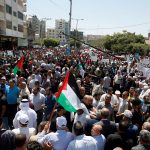
Hundreds of Palestinians begin a march along the road from Jericho to the Allenby Bridge, with the slogan “leaving the ghetto of Jericho,” and block the Jordan Valley highway.
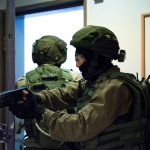
On the afternoon of August 2, the Israeli Police receive a report that an Israeli couple who had traveled the previous evening to the community of Mevo Dotan have disappeared. Cellular tracking shows that they were last identified in the area of Jenin. No organization claims responsibility, and nothing is known of the whereabouts of the victims. At this stage, there is no security coordination between Israel and the Palestinian security forces

The IDF Liaison Unit receives a request from the Jordanian Air Force to allow the Jordanian King to fly on his royal helicopter to Ramallah in order to meet with President Abbas. The assessment is that the King, together with the Secretary General of the Arab League, plans to participate in a ceremony to mark the establishment of the Palestinian state. Israel approves the flight on condition that the King does not attend this ceremony. Nevertheless, King Abdullah II arrives in Ramallah on August 2 and marches toward Jerusalem at the head of a parade with Abbas and the Secretary General of the Arab League. Russian Foreign Minister Sergey Lavrov calls on Israel and the Palestinians to stop the deterioration, and invites the parties to an emergency meeting of the Quartet in Moscow in order to discuss the implications of the annexation and the rapid return to a political process.
On August 3, the government decision to annex the settlement blocs surrounding Jerusalem is passed. The decision accelerates events on the ground: there are riots along the border fence between Israel and the Gaza Strip, with people killed on the Palestinian side. There are riots on the Temple Mount, as young Palestinians take over the Golden Gate and barricade themselves there; two Palestinian youths are killed in a confrontation with Israeli police forces. There is intensifying violence throughout the West Bank, including many attacks on Israeli vehicles traveling along the major routes. Confrontations develop between Palestinians and Israelis, with both sides trying to take over commanding hilltops in Area C. Rocket and mortar fire continue toward Israeli communities near the Gaza Strip. Construction infrastructure at the Cave of the Patriarchs is destroyed, and a “price tag” attack occurs in response, when a mosque in Hebron is torched. The IDF is forced to call up reserves, and there are increasing protests of “for what” among those mobilized.

The events expand beyond the Palestinian sphere. Iran takes advantage of the fact that international attention is focused on the Palestinian issue, and announces that it is enriching uranium to 20 percent and going to leave the NPT. Three rockets are fired from the area of Sidon (South Lebanon). Turkey encourages mass violence by Palestinian youths on the Temple Mount, and sends three frigates to positions opposite the Gaza coast. Mass violent demonstrations are held in Amman, demanding the cancellation of the peace treaty with Israel and insisting that the closure of the Jordanian embassy in Israel is not sufficient. King Abdullah is forced to freeze peace relations completely and demand the evacuation of the Israeli embassy in Amman.
Searching for a way out: At the Quartet meeting in Moscow on August 4, a decision is reached calling on the parties to return immediately to the negotiating table. Israel is asked to suspend its annexation steps, and the Palestinian Authority is called on to recede from its declaration of independence. According to the decision, the negotiations will last for one year, unless the parties agree to extend them. According to the decision, both parties will commit to act in accordance with the Oslo Accords, and avoid steps during the negotiations that may harm the realization of a two-state solution. The negotiations will be conducted with no prior conditions, and based on the Arab Peace Initiative, President Trump’s peace plan, and prior relevant international decisions. All the parties accede to the Quartet’s decision as a mechanism to stop the escalation and regroup.
The Actors and their Rationales
 Israel: The Israeli government contends that the Trump administration provided it with a strategic opportunity to apply Israeli sovereignty over areas considered essential to Israel, and thereby show the world that there are areas that Israel will not cede in any political arrangement. This also proves to the Palestinians that time is not on their side and that they no longer have the power to veto every potential arrangement. Israel is working for regional and international acceptance of its application of sovereignty. When the annexation decision was made public, the Israeli government adopted a strategy that focused mainly on containment and rapid calming of the area that was expected to heat up, with an emphasis on thwarting terrorism (and on stopping possible provocations on the part of Jewish residents). The government calls for negotiations with the Palestinians on the basis of the Trump plan. Professional echelons also work on maintaining the strategic relationship and diplomatic ties with Jordan, Egypt, and Gulf states. Israel responds favorably to the Quartet initiative but conditioned its acceptance on the Palestinian Authority returning immediately to the discussion table and examining the sincerity of its intentions until September.
Israel: The Israeli government contends that the Trump administration provided it with a strategic opportunity to apply Israeli sovereignty over areas considered essential to Israel, and thereby show the world that there are areas that Israel will not cede in any political arrangement. This also proves to the Palestinians that time is not on their side and that they no longer have the power to veto every potential arrangement. Israel is working for regional and international acceptance of its application of sovereignty. When the annexation decision was made public, the Israeli government adopted a strategy that focused mainly on containment and rapid calming of the area that was expected to heat up, with an emphasis on thwarting terrorism (and on stopping possible provocations on the part of Jewish residents). The government calls for negotiations with the Palestinians on the basis of the Trump plan. Professional echelons also work on maintaining the strategic relationship and diplomatic ties with Jordan, Egypt, and Gulf states. Israel responds favorably to the Quartet initiative but conditioned its acceptance on the Palestinian Authority returning immediately to the discussion table and examining the sincerity of its intentions until September.
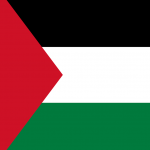 The Palestinian Authority: The failure to stop the annexation, along with the continuing erosion of its legitimacy, partly due to the ongoing political freeze, led the PA to look for a new platform that would allow it to realize the goal of establishing an independent Palestinian state that would win international recognition. President Abbas adopts Arafat’s method of walking the edge while canceling agreements, without controlling events, and disengaging from Israel while attempting to draw closer to Hamas and Islamic Jihad. He intends to play for time until the US presidential elections in November 2020, hoping for a change of administration in Washington. As such, the chosen path is unarmed popular revolt, while maintaining a high level of friction with Israeli security forces. However, the PA toolbox proves limited. Arab countries in particular, and the international community in general, support it with words, but less in deed, and monetary assistance has been significantly cut back. The Tanzim militia, which was marked as a game changer, is not under PA control. Hamas is apparently cooperating, but is acting as a double agent and also undermining its rule in the West Bank. The Palestinian street has not responded in a broad or significant way to the call to take part in the popular revolt. Abbas realizes that the Quartet initiative is the only way to maintain his relevance; he responds positively to the proposal and is ready to accept the Trump initiative as the terms of reference.
The Palestinian Authority: The failure to stop the annexation, along with the continuing erosion of its legitimacy, partly due to the ongoing political freeze, led the PA to look for a new platform that would allow it to realize the goal of establishing an independent Palestinian state that would win international recognition. President Abbas adopts Arafat’s method of walking the edge while canceling agreements, without controlling events, and disengaging from Israel while attempting to draw closer to Hamas and Islamic Jihad. He intends to play for time until the US presidential elections in November 2020, hoping for a change of administration in Washington. As such, the chosen path is unarmed popular revolt, while maintaining a high level of friction with Israeli security forces. However, the PA toolbox proves limited. Arab countries in particular, and the international community in general, support it with words, but less in deed, and monetary assistance has been significantly cut back. The Tanzim militia, which was marked as a game changer, is not under PA control. Hamas is apparently cooperating, but is acting as a double agent and also undermining its rule in the West Bank. The Palestinian street has not responded in a broad or significant way to the call to take part in the popular revolt. Abbas realizes that the Quartet initiative is the only way to maintain his relevance; he responds positively to the proposal and is ready to accept the Trump initiative as the terms of reference.
 Hamas in the Gaza Strip aims, like the PA, to torpedo the annexation plan and remove the Trump plan from the international agenda. However, the annexation, both as an intention and particularly if implemented, gives Hamas an opportunity to improve its standing in the Palestinian arena as a leader of the resistance, in view of the failure of the PA’s political path. Hamas is not interested in escalation in the Gaza Strip, since it will damage the advantages inherent in an arrangement with Israel and in money transfers from Qatar. However, escalation in the West Bank would enable the organization to position itself as an alternative to the PA and Fatah. Therefore, its leadership chooses to encourage and initiate terrorist attacks and violence in the West Bank, while maintaining a low level of attacks from the Gaza Strip. This initiative presumes that Israel is not interested in a broad military campaign in Gaza, and its response to the attacks will therefore be limited.
Hamas in the Gaza Strip aims, like the PA, to torpedo the annexation plan and remove the Trump plan from the international agenda. However, the annexation, both as an intention and particularly if implemented, gives Hamas an opportunity to improve its standing in the Palestinian arena as a leader of the resistance, in view of the failure of the PA’s political path. Hamas is not interested in escalation in the Gaza Strip, since it will damage the advantages inherent in an arrangement with Israel and in money transfers from Qatar. However, escalation in the West Bank would enable the organization to position itself as an alternative to the PA and Fatah. Therefore, its leadership chooses to encourage and initiate terrorist attacks and violence in the West Bank, while maintaining a low level of attacks from the Gaza Strip. This initiative presumes that Israel is not interested in a broad military campaign in Gaza, and its response to the attacks will therefore be limited.
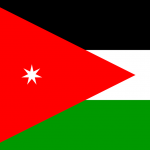 Jordan: From its standpoint, the intention to annex reflects an Israeli decision to engage in confrontation. The pressure in Jordan was not relaxed even after it became clear that Israel did not intend to annex the Jordan Valley. The kingdom has an existential interest in maintaining the two-state solution, and the collapse of the PA may encourage the idea of Jordan as an alternative Palestinian state. At the same time, Jordan has an interest in maintaining security cooperation with Israel, even if on a reduced scale, and it depends on Israel for the supply of water and energy. Undermining stability in the West Bank may spill over to the eastern bank of the Jordan River.
Jordan: From its standpoint, the intention to annex reflects an Israeli decision to engage in confrontation. The pressure in Jordan was not relaxed even after it became clear that Israel did not intend to annex the Jordan Valley. The kingdom has an existential interest in maintaining the two-state solution, and the collapse of the PA may encourage the idea of Jordan as an alternative Palestinian state. At the same time, Jordan has an interest in maintaining security cooperation with Israel, even if on a reduced scale, and it depends on Israel for the supply of water and energy. Undermining stability in the West Bank may spill over to the eastern bank of the Jordan River.
 The United States: The annexation process and its reduced scope was coordinated between Jerusalem and Washington, in order to chart a balanced path between realizing the step and maintaining the relevance of the Trump plan. The Trump administration, which is focused on the presidential election campaign, expected that the application of sovereignty would strengthen the President’s evangelical support base, and wanted to maintain the Trump plan as a basis for an Israeli-Palestinian political process and the formulation of a regional treaty led by the United States that would include the Gulf states, Egypt, Jordan, and Israel. The dynamic of the game illustrated the strength of US leadership in the Middle East, as well as the positioning of the relevance of the Trump plan. Like the Republican administration, Democratic presidential candidate Joe Biden sent the Palestinians a message that mainly contained a recommendation to avoid major reactions and to wait for the results of the presidential elections.
The United States: The annexation process and its reduced scope was coordinated between Jerusalem and Washington, in order to chart a balanced path between realizing the step and maintaining the relevance of the Trump plan. The Trump administration, which is focused on the presidential election campaign, expected that the application of sovereignty would strengthen the President’s evangelical support base, and wanted to maintain the Trump plan as a basis for an Israeli-Palestinian political process and the formulation of a regional treaty led by the United States that would include the Gulf states, Egypt, Jordan, and Israel. The dynamic of the game illustrated the strength of US leadership in the Middle East, as well as the positioning of the relevance of the Trump plan. Like the Republican administration, Democratic presidential candidate Joe Biden sent the Palestinians a message that mainly contained a recommendation to avoid major reactions and to wait for the results of the presidential elections.
 Pragmatic Arab states all wanted to avoid being seen as “traitors” to the Palestinian cause, yet were also limited by their interest to avoid a frontal confrontation with the Trump administration and with Israel, experiencing a deterioration into regional violence, and having Turkey and Iran take the opportunity to establish their regional positions. They worked to advance conditions to renew the Israeli-Palestinian political process, or at least to lead to a suspension of the annexation and a freeze of the situation until after the US presidential elections. At the same time, they worked to soften Jordanian opposition to the annexation, demanding that Amman not deviate too much from the Arab collective. This was all done with a low profile, while monitoring internal and external reactions and developments, while also suspending public expressions of normalization with Israel. At the same time, strategic coordination channels were kept open between them and the United States and Israel.
Pragmatic Arab states all wanted to avoid being seen as “traitors” to the Palestinian cause, yet were also limited by their interest to avoid a frontal confrontation with the Trump administration and with Israel, experiencing a deterioration into regional violence, and having Turkey and Iran take the opportunity to establish their regional positions. They worked to advance conditions to renew the Israeli-Palestinian political process, or at least to lead to a suspension of the annexation and a freeze of the situation until after the US presidential elections. At the same time, they worked to soften Jordanian opposition to the annexation, demanding that Amman not deviate too much from the Arab collective. This was all done with a low profile, while monitoring internal and external reactions and developments, while also suspending public expressions of normalization with Israel. At the same time, strategic coordination channels were kept open between them and the United States and Israel.
 The international community: As the gatekeeper of the two-state solution, there were bitter reactions to the Israeli process of applying sovereignty in the West Bank. Condemnations were issued in various international forums, contacts and agreements with Israel were suspended, products from Jewish settlements in the West Bank were identified and marked as such more stringently, and there was greater strictness about not implementing agreements with parties in the areas annexed to Israel. No country other than the United States recognized Israeli sovereignty over the annexed areas, while many countries recognized the Palestinian state. The Chief Prosecutor at the International Criminal Court (ICC) in The Hague argued that there is a basis for believing that Israel committed war crimes.
The international community: As the gatekeeper of the two-state solution, there were bitter reactions to the Israeli process of applying sovereignty in the West Bank. Condemnations were issued in various international forums, contacts and agreements with Israel were suspended, products from Jewish settlements in the West Bank were identified and marked as such more stringently, and there was greater strictness about not implementing agreements with parties in the areas annexed to Israel. No country other than the United States recognized Israeli sovereignty over the annexed areas, while many countries recognized the Palestinian state. The Chief Prosecutor at the International Criminal Court (ICC) in The Hague argued that there is a basis for believing that Israel committed war crimes.
Lessons and Insights
The regional and international environment: The image of Israel as a “regional bully” that does not comply with norms, international law, or the rules of the game, while enjoying full American backing, is prevalent. The dynamic of the game showed that if Biden is elected president, he may withdraw American recognition of the annexation, and perhaps the protection of the American veto on a decision against Israel that is not binding in the Security Council. In that case, relations between Israel and the Democratic Party in the US will be seriously harmed.
The more the violence in the Israeli-Palestinian sphere intensified and the campaign expanded to the Gaza Strip and to rocket fire from southern Lebanon (by Palestinian organizations), it became clear that actors in the direct confrontation circle with Israel and in the broader regional circle have no interest in an escalation to a broader conflict. These parties were quick to embrace the Quartet’s initiative as an exit from the cycle of violence. The Palestinian Authority, which stridently rejected the Trump plan, now accepted it as the basis for negotiations, alongside the Arab Peace Initiative. The Israeli government agreed to join the process aimed at a two-state solution. The international community, which held that the Trump plan was not legitimate, accepted it as the basis for negotiations toward a two-state solution, and pragmatic Arab states, except for Jordan, expressed readiness to show flexibility with their detailed demands in the Arab Initiative. The Trump administration won recognition for its plan, and therefore agreed to broad sponsorship of the political process by the Quartet.
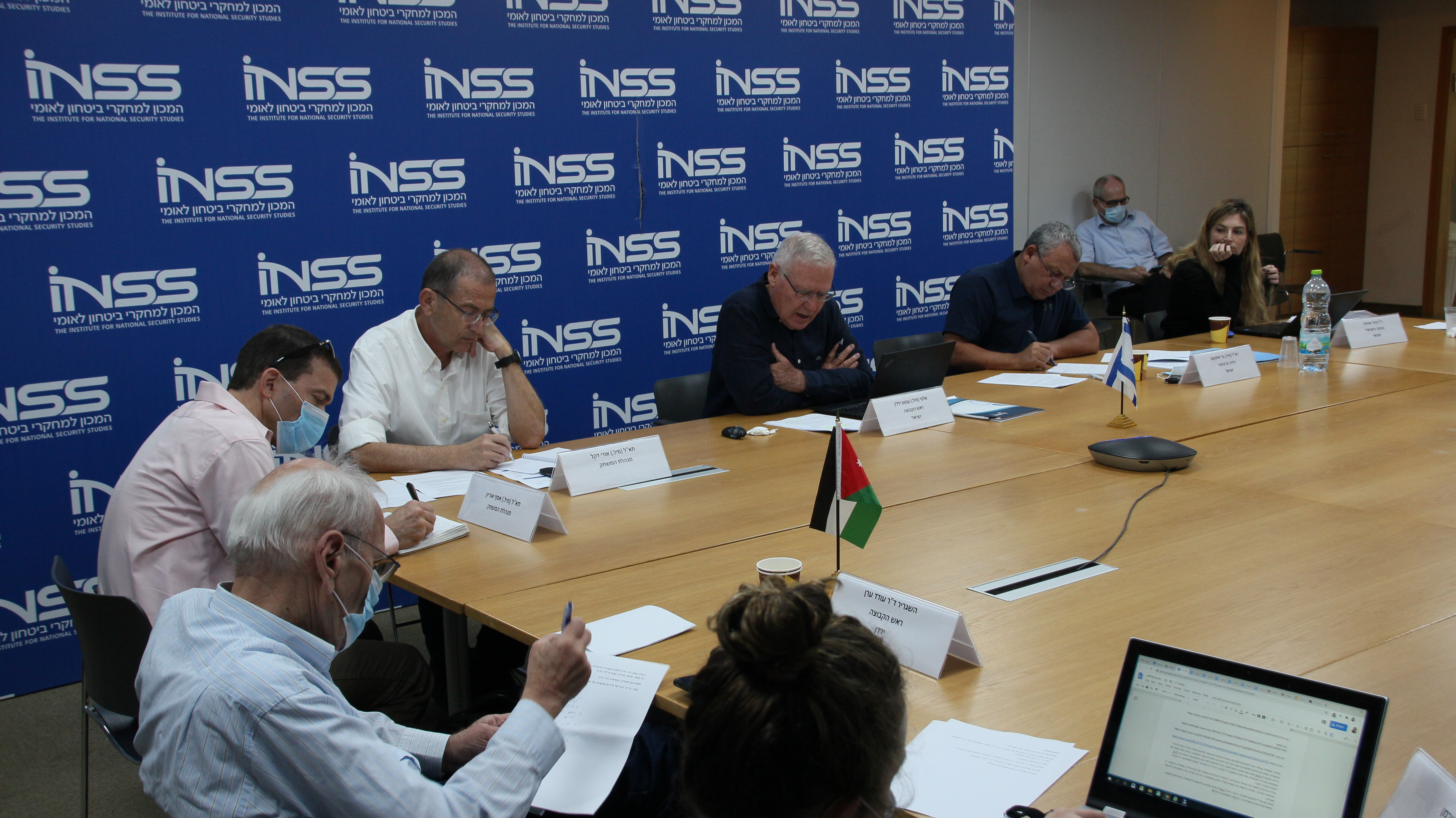
The Israeli public: Support for the annexation move declined as its price became more evident – international condemnations and pressure, a heavier burden on the economy that was already in crisis, and an escalation of violence in the Palestinian sphere and perhaps even in the northern area. As opposed to the political stalemate for which the Palestinians were mainly viewed as responsible, a unilateral Israeli annexation would cause Israel to be viewed as the party solely responsible for the escalation.
The Palestinian leadership is in serious strategic distress, and has even expressed readiness to take steps that may lead to its dissolution and “give back the keys” to Israel. The coronavirus crisis and the economic crisis in the Palestinian Authority have also made it more difficult for it to function. Abbas, despite his refusal to return to the negotiating table and his contrarian behavior, understood that he is losing relevance in both the internal and international spheres, but the Quartet’s proposal gave him a lifeline, and positioned the Palestinian Authority as the sole representative of the Palestinian people, in addition to increasing the chances of renewed assistance from donations from Western and Gulf countries to the PA’s collapsing economy.
Over the past decade, Israel’s security policy has focused on thwarting and disrupting Iran’s progress toward military nuclear capability and consolidation in the northern arena. At the same time, Israel has been able to push the Palestinian issue to the margins of the regional and international agendas. However, the annexation option has returned the Palestinian problem to center stage. Iran exploited the renewed interest in the Israel-Palestinian dispute (and the coronavirus crisis) to continue breaching the commitments that it took upon itself in the nuclear agreement. (In the game, the US President rejected an Israeli request to attack Iran's nuclear infrastructure.) This development, along with the growing escalation in the Palestinian arena, spurred Israel to join the Quartet’s path for an arrangement with the Palestinians in order to retrain the focus on the Iranian issue. However, it became clear that tactical events are what determine Israeli strategy. This tendency was illustrated during the war game, and showed that the decision making process reflects short-term thinking that does not take into account all of the direct or indirect consequences of dramatic steps that change the rules of the game. The war game found a way out of the trap, but it is questionable whether in reality this exit will be accessible or practical.



